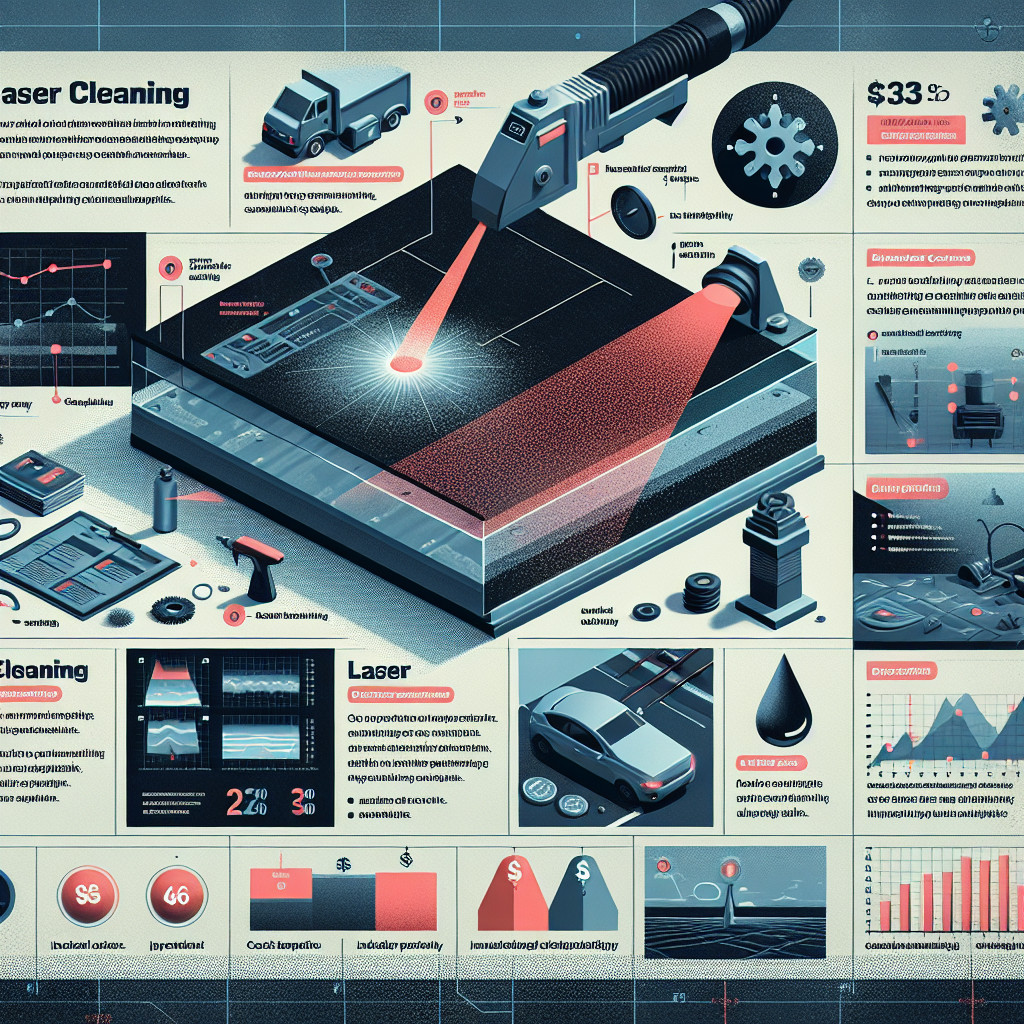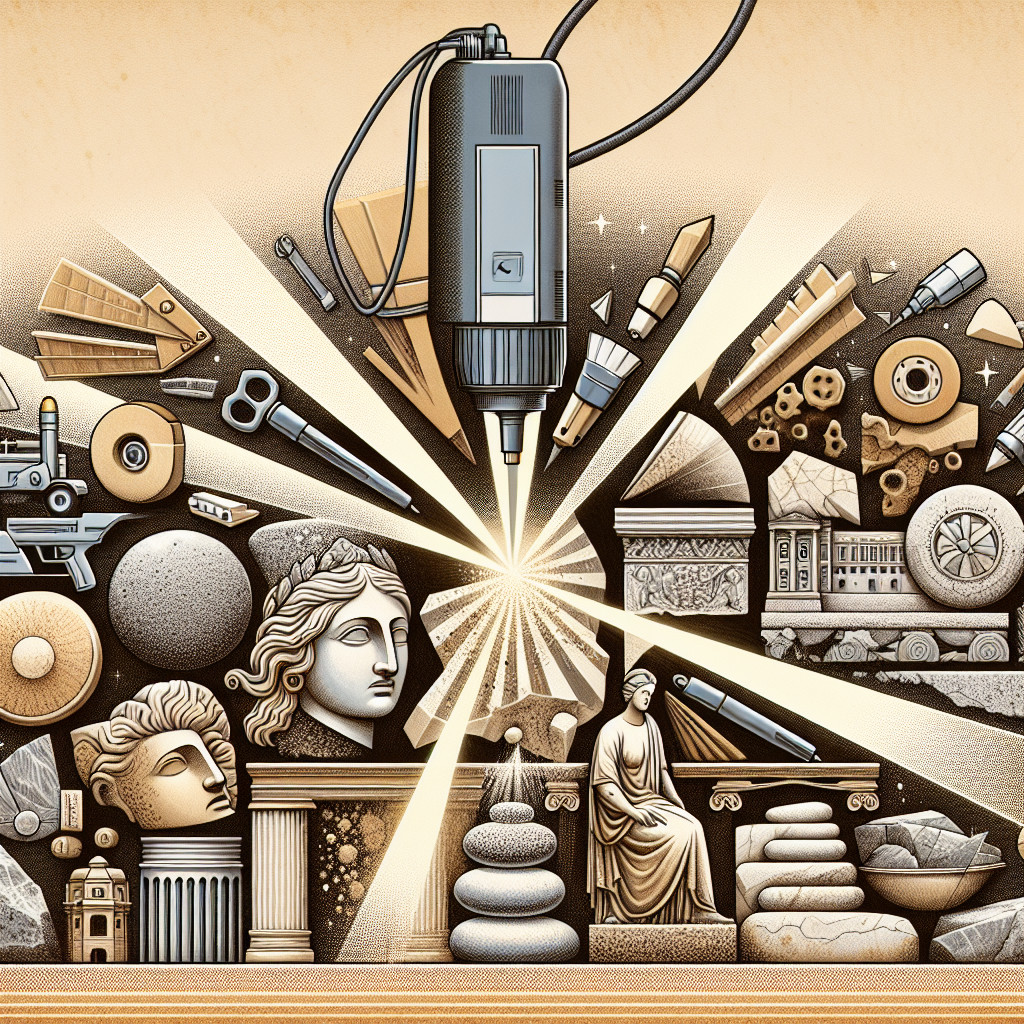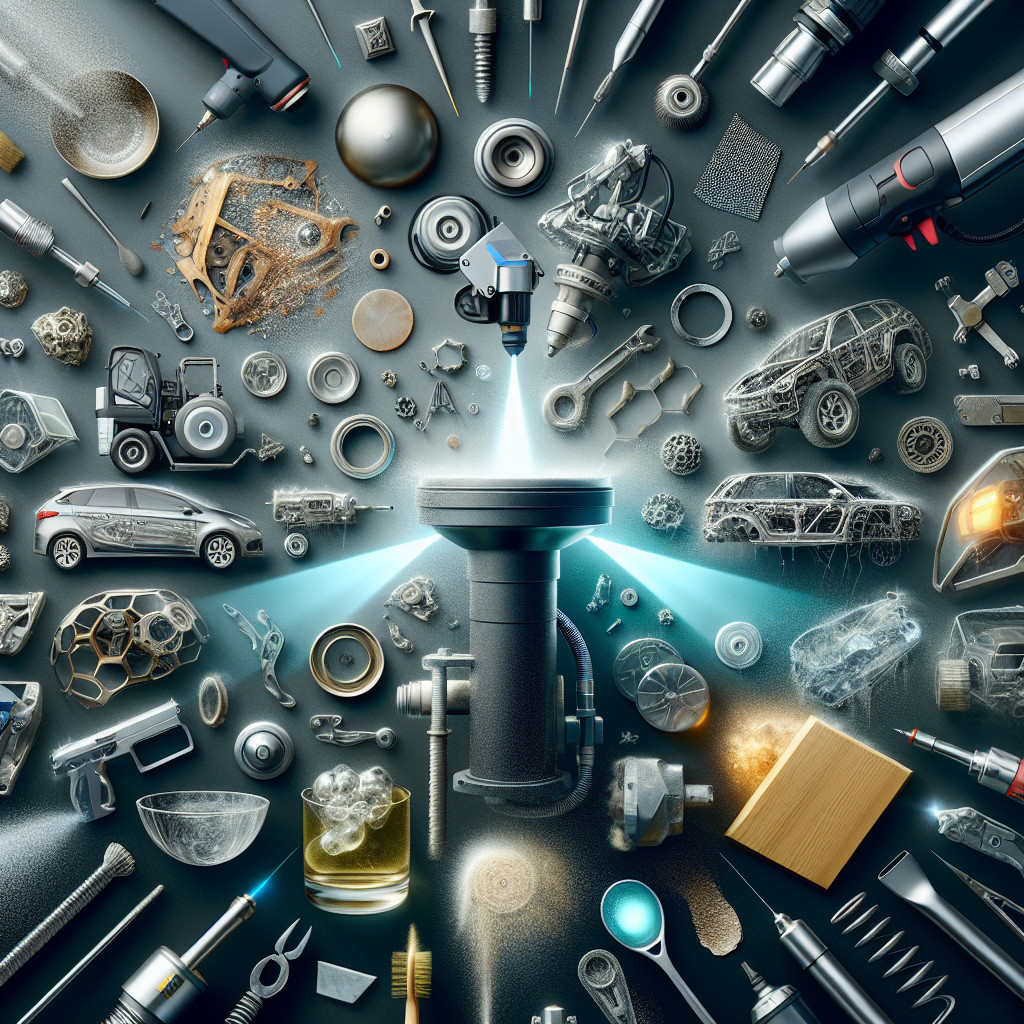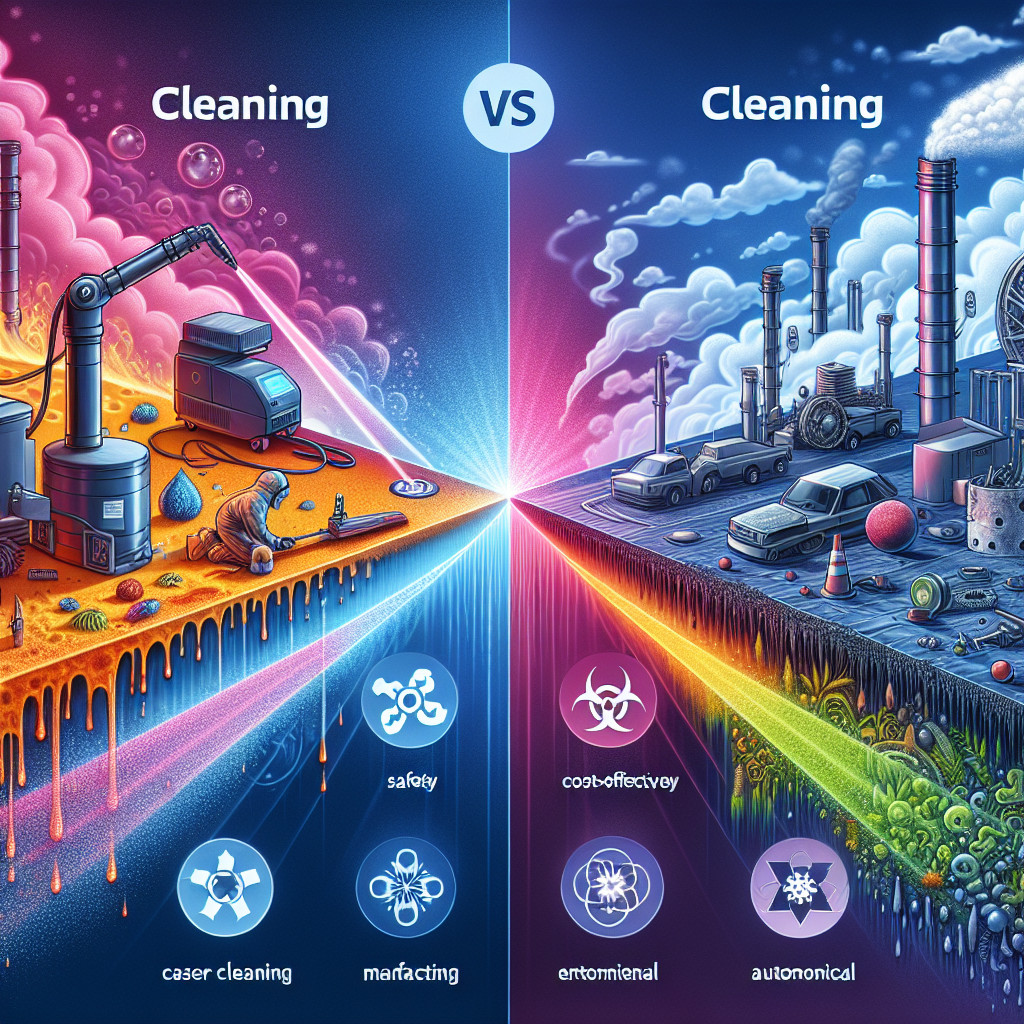- Different types of lasers used in cleaning
- Preparing the surface for laser cleaning
- Cleaning different types of materials with lasers
- Cleaning delicate and sensitive surfaces with lasers
- Laser cleaning in the automotive industry
- Laser cleaning in the medical field
- Laser cleaning in the restoration of buildings and monuments
- Laser cleaning in the oil and gas industry
Different types of lasers used in cleaning
Pierwszym rodzajem lasera, który zostanie omówiony, jest laser CO2. Jest to najczęściej stosowany laser w procesie czyszczenia, ze względu na swoją wszechstronność i skuteczność. Laser CO2 wykorzystuje wiązkę promieniowania podczerwonego, która jest absorbowana przez zanieczyszczenia na powierzchni. Następnie energia jest przekazywana do zanieczyszczeń, powodując ich odparowanie lub odłupywanie od podłoża. Laser CO2 jest skuteczny w usuwaniu farby, nalotów, rdzy i innych trudnych do usunięcia substancji.
Kolejnym rodzajem lasera jest laser Nd:YAG. Ten rodzaj lasera jest często stosowany do czyszczenia powierzchni metalowych. Laser Nd:YAG emituje wiązkę promieniowania o długości fali 1064 nm, która jest dobrze absorbowana przez metale. Energia lasera jest przekazywana do zanieczyszczeń, powodując ich odparowanie lub odłupywanie od powierzchni. Laser Nd:YAG jest skuteczny w usuwaniu nalotów, farby, oleju i innych substancji z metalowych powierzchni.
Innym rodzajem lasera stosowanym w czyszczeniu jest laser diodowy. Laser diodowy emituje wiązkę promieniowania o wysokiej intensywności, która jest skierowana na powierzchnię do czyszczenia. Energia lasera jest absorbowana przez zanieczyszczenia, powodując ich odparowanie lub odłupywanie od podłoża. Laser diodowy jest skuteczny w usuwaniu nalotów, farby, oleju i innych substancji z różnych powierzchni.
Kolejnym rodzajem lasera jest laser femtosekundowy. Ten rodzaj lasera emituje bardzo krótkie impulsy o długości fali w zakresie femtosekund (10^-15 sekundy). Laser femtosekundowy jest skuteczny w usuwaniu zanieczyszczeń, farby, nalotów i innych substancji z delikatnych powierzchni, takich jak szkło, ceramika i tworzywa sztuczne. Dzięki bardzo krótkim impulsom, laser femtosekundowy minimalizuje ryzyko uszkodzenia powierzchni.
Ostatnim rodzajem lasera, który zostanie omówiony, jest laser ekskimerowy. Laser ekskimerowy emituje wiązkę promieniowania o długości fali w zakresie ultrafioletu. Jest to skuteczny laser do usuwania farby, nalotów, rdzy i innych substancji z różnych powierzchni. Laser ekskimerowy jest często stosowany w przemyśle motoryzacyjnym i lotniczym do czyszczenia powierzchni metalowych.
Warto zauważyć, że każdy rodzaj lasera ma swoje unikalne właściwości i zastosowania. Wybór odpowiedniego lasera do czyszczenia zależy od rodzaju zanieczyszczeń, rodzaju powierzchni i innych czynników. W zależności od potrzeb, można również stosować kombinacje różnych rodzajów laserów w celu osiągnięcia najlepszych wyników.
Kluczowe słowa: lasery, czyszczenie, laser CO2, laser Nd:YAG, laser diodowy, laser femtosekundowy, laser ekskimerowy.
Frazy kluczowe: różne rodzaje laserów stosowanych w czyszczeniu, zastosowanie laserów w usuwaniu zanieczyszczeń, właściwości laserów stosowanych w czyszczeniu, skuteczność laserów w czyszczeniu powierzchni, wybór odpowiedniego lasera do czyszczenia.
Preparing the surface for laser cleaning
Kolejnym krokiem jest oczyszczenie powierzchni z wszelkich luźnych cząstek, takich jak kurz, pył, piasek itp. Może to być osiągnięte poprzez zastosowanie odkurzacza przemysłowego lub sprężonego powietrza. Usunięcie tych cząstek jest ważne, ponieważ mogą one wpływać na skuteczność czyszczenia laserowego i mogą spowodować uszkodzenie powierzchni.
Następnie, powierzchnia musi być dokładnie odtłuszczona. Tłuszcz i olej mogą utrudniać skuteczne czyszczenie laserowe, dlatego ważne jest usunięcie tych substancji przed przystąpieniem do procesu czyszczenia. Istnieje wiele dostępnych na rynku środków chemicznych do odtłuszczania, które mogą być stosowane w zależności od rodzaju powierzchni i rodzaju zanieczyszczeń.
Po odtłuszczeniu powierzchni, można przystąpić do czyszczenia laserowego. Istnieje wiele różnych rodzajów laserów, które mogą być stosowane do czyszczenia, takich jak lasery CO2, lasery Nd:YAG, lasery diodowe itp. Wybór odpowiedniego lasera zależy od rodzaju materiału, który ma być oczyszczany, oraz rodzaju zanieczyszczeń, które mają być usunięte.
Podczas czyszczenia laserowego, intensywna wiązka laserowa jest skierowana na powierzchnię, co powoduje odparowanie lub odłuszczenie zanieczyszczeń. Proces ten jest bardzo precyzyjny i kontrolowany, co pozwala na skuteczne usuwanie zanieczyszczeń bez uszkadzania powierzchni. Jednakże, istnieje kilka czynników, które mogą wpływać na skuteczność czyszczenia laserowego, takie jak moc lasera, czas naświetlania, odległość od powierzchni itp.
Po zakończeniu czyszczenia laserowego, powierzchnia może wymagać dodatkowego oczyszczenia, aby usunąć resztki zanieczyszczeń. Może to być osiągnięte poprzez zastosowanie środków chemicznych lub mechanicznych, takich jak szczotki, gąbki, wodne strumienie itp.
Ważne jest również, aby pamiętać o bezpieczeństwie podczas przygotowywania powierzchni do czyszczenia laserowego. Laserowe czyszczenie może generować intensywne promieniowanie, które może być szkodliwe dla oczu i skóry. Dlatego konieczne jest stosowanie odpowiednich środków ochrony, takich jak okulary ochronne i rękawice, aby zapewnić bezpieczne środowisko pracy.
Podsumowując, przygotowanie powierzchni do czyszczenia laserowego jest niezbędnym etapem, który ma kluczowe znaczenie dla osiągnięcia optymalnych rezultatów. Odpowiednie przygotowanie powierzchni, włączając w to ocenę zanieczyszczeń, oczyszczenie z luźnych cząstek, odtłuszczenie i wybór odpowiedniego lasera, pozwala na skuteczne i bezpieczne czyszczenie. Słowa kluczowe: czyszczenie laserowe, przygotowanie powierzchni, zanieczyszczenia, odtłuszczanie, laser CO2, laser Nd:YAG, bezpieczeństwo. Frazy kluczowe: skuteczne czyszczenie laserowe, usuwanie zanieczyszczeń laserem, laserowe czyszczenie powierzchni, przygotowanie powierzchni do czyszczenia laserowego.
Cleaning different types of materials with lasers
When it comes to cleaning metals, lasers can effectively remove rust, oxides, and other surface contaminants without damaging the underlying material. The laser beam is directed at the surface, causing the contaminants to vaporize or sublimate, leaving behind a clean and pristine surface. This process is non-abrasive and does not generate any waste, making it an environmentally friendly option.
For cleaning plastics, lasers can remove dirt, grease, adhesives, and even unwanted markings or labels. The laser energy is absorbed by the contaminants, causing them to heat up and evaporate. This gentle cleaning method ensures that the plastic surface remains intact and undamaged.
Ceramic surfaces, such as tiles or pottery, can also benefit from laser cleaning. The laser beam can remove stains, mold, or discoloration without affecting the surface texture or glaze. This allows for precise cleaning and restoration of ceramic objects, preserving their original beauty.
Glass cleaning is another area where lasers excel. They can remove dirt, fingerprints, or even stubborn stains from glass surfaces, including windows, mirrors, or glassware. Laser cleaning ensures streak-free results and eliminates the need for harsh chemicals or abrasive materials.
When it comes to delicate surfaces like artwork or historical artifacts, laser cleaning offers a gentle and non-invasive solution. The laser beam can remove dirt, smoke residues, or varnish layers without causing any damage to the underlying material. This makes it an invaluable tool for conservators and restorers, allowing them to preserve and protect valuable cultural heritage.
In addition to its versatility, laser cleaning also offers other advantages. It is a contactless method, which means that there is no physical contact between the cleaning tool and the object being cleaned. This eliminates the risk of scratching or damaging the surface. Laser cleaning is also a dry process, which means that it does not require the use of water or other cleaning agents. This makes it suitable for applications where moisture could be detrimental, such as electronics or precision instruments.
In conclusion, laser cleaning is a highly effective and versatile method for cleaning different types of materials. Its non-abrasive, non-contact, and dry nature make it an environmentally friendly and safe option for various applications. Whether it’s removing rust from metals, dirt from plastics, stains from ceramics, or grime from glass, lasers can provide a precise and efficient cleaning solution.
Keywords: laser cleaning, materials, metals, plastics, ceramics, glass, delicate surfaces, environment, restoration, non-abrasive, non-contact, dry cleaning.
Long-tail phrases:
– Laser cleaning for rust removal on metals
– Gentle cleaning of delicate surfaces with lasers
– Laser cleaning for preserving cultural heritage
– Non-abrasive cleaning method for plastics
– Efficient cleaning of ceramics with laser technology
– Streak-free glass cleaning with lasers
– Environmentally friendly cleaning solution with lasers
– Dry cleaning process for electronics and precision instruments.
Cleaning delicate and sensitive surfaces with lasers
One of the key benefits of laser cleaning is its ability to remove contaminants without the need for chemicals or abrasive materials. Traditional cleaning methods often involve the use of harsh chemicals that can be harmful to both the environment and human health. Laser cleaning, on the other hand, utilizes the power of focused light to break down and vaporize contaminants, leaving behind a clean surface without any residue.
The process of laser cleaning involves the use of a high-intensity laser beam that is directed towards the surface to be cleaned. The laser beam interacts with the contaminants, causing them to heat up and expand rapidly. This thermal shock breaks the bond between the contaminants and the surface, allowing them to be easily removed. The laser beam can be adjusted in terms of intensity and focus, making it suitable for cleaning different types of surfaces with varying levels of sensitivity.
Another advantage of laser cleaning is its precision. The laser beam can be controlled with great accuracy, allowing for targeted cleaning of specific areas without affecting the surrounding surface. This level of precision is particularly beneficial when cleaning intricate or complex surfaces, where traditional methods may struggle to reach all the nooks and crannies.
Furthermore, laser cleaning is a highly efficient process. The speed and effectiveness of laser cleaning make it a cost-effective solution for industries that require frequent and thorough cleaning of delicate surfaces. The non-contact nature of laser cleaning also reduces the risk of wear and tear on cleaning equipment, resulting in longer-lasting and more reliable cleaning solutions.
Despite its numerous advantages, laser cleaning does have some limitations. For instance, certain materials may absorb the laser energy, leading to discoloration or damage. It is essential to conduct thorough testing and analysis before implementing laser cleaning on sensitive surfaces to ensure compatibility and prevent any potential harm.
In conclusion, laser cleaning offers a safe, efficient, and precise method for cleaning delicate and sensitive surfaces. Its non-contact nature, ability to remove contaminants without chemicals, and high level of precision make it an ideal solution for industries that require gentle yet effective cleaning. As technology continues to advance, laser cleaning is likely to become even more versatile and widely adopted in various sectors.
Keywords: laser cleaning, delicate surfaces, sensitive surfaces, non-contact cleaning, contaminants, precision, efficiency, cost-effective, limitations, compatibility.
Long-tail phrases:
1. Laser cleaning for delicate surfaces without damage.
2. Non-contact cleaning methods for sensitive materials.
3. Advantages of laser cleaning over traditional methods.
4. Precision cleaning with lasers for intricate surfaces.
5. Cost-effective solutions for frequent and thorough cleaning.
6. Limitations and considerations for laser cleaning on sensitive surfaces.
7. Compatibility testing for laser cleaning applications.
Laser cleaning in the automotive industry
Another significant advantage of laser cleaning is its versatility. It can be used to clean a wide range of automotive components, including engine parts, brake calipers, fuel injectors, and even delicate electronic circuit boards. This versatility makes laser cleaning a cost-effective solution for automotive manufacturers, as it eliminates the need for multiple cleaning methods and reduces downtime.
In addition to its cleaning capabilities, laser technology also offers benefits in terms of sustainability and environmental impact. Traditional cleaning methods often involve the use of harsh chemicals and solvents, which can be harmful to both the environment and human health. Laser cleaning, on the other hand, is a non-contact and chemical-free process, making it a safer and more eco-friendly alternative.
Furthermore, laser cleaning is a highly efficient process that can significantly reduce cleaning time and increase productivity. Traditional cleaning methods often require manual labor and extensive preparation, whereas laser cleaning can be automated and integrated into existing production lines. This not only saves time but also reduces labor costs and improves overall efficiency.
The automotive industry is constantly striving to improve the quality and performance of its products. Laser cleaning plays a crucial role in achieving these goals by ensuring that components are free from contaminants and coatings that can affect their functionality. By using laser cleaning, manufacturers can enhance the durability and reliability of their products, leading to increased customer satisfaction and loyalty.
In conclusion, laser cleaning has revolutionized the automotive industry by offering a safe, efficient, and versatile cleaning solution. Its ability to remove contaminants without causing damage, its sustainability, and its potential for automation make it an ideal choice for automotive manufacturers and service providers. As the industry continues to evolve, laser cleaning will undoubtedly play an even more significant role in ensuring the quality and performance of automotive components.
Keywords: laser cleaning, automotive industry, contaminants, coatings, delicate components, versatile, cost-effective, sustainability, environmental impact, non-contact, chemical-free, efficient, productivity, durability, reliability, customer satisfaction, automation.
Long-tail phrases: laser cleaning in automotive manufacturing, benefits of , laser cleaning for delicate automotive components, sustainability of laser cleaning in automotive applications, automation of laser cleaning in automotive production lines.
Laser cleaning in the medical field
Another area where laser cleaning is widely used is in dental care. Dental instruments, such as drills and scalers, are prone to contamination with saliva, blood, and other bodily fluids. Laser cleaning provides a quick and efficient method of sterilizing these instruments, ensuring that they are safe for use on patients. Additionally, laser cleaning can be used to remove plaque and tartar from teeth, offering a less invasive alternative to traditional scaling and root planing procedures.
Laser cleaning also plays a crucial role in maintaining cleanliness in medical facilities. Hospital surfaces, including floors, walls, and equipment, can harbor harmful bacteria and viruses. Traditional cleaning methods may not effectively eliminate these pathogens, leading to the spread of infections. Laser cleaning, however, can target and destroy microorganisms, ensuring a safer environment for patients and healthcare workers.
In dermatology, laser cleaning is utilized for tattoo removal and scar revision. Laser beams can break down the ink particles in tattoos, allowing the body to naturally eliminate them over time. This non-invasive procedure offers a more effective and less painful alternative to traditional tattoo removal methods. Laser cleaning can also be used to reduce the appearance of scars by stimulating collagen production and promoting skin regeneration.
Furthermore, laser cleaning has found applications in ophthalmology. Laser technology is used in procedures such as LASIK, where a laser is used to reshape the cornea and correct vision problems. Laser cleaning is also employed in the cleaning and maintenance of delicate ophthalmic instruments, ensuring their longevity and effectiveness.
In summary, laser cleaning has become an indispensable tool in the medical field. Its precision, efficiency, and ability to sterilize surfaces make it an ideal solution for various applications. From surgical instruments to dental care, from maintaining cleanliness in medical facilities to tattoo removal and scar revision, laser cleaning offers numerous benefits. As technology continues to advance, laser cleaning will likely play an even more significant role in improving patient care and safety.
Keywords: laser cleaning, medical field, surgical procedures, dental care, sterilization, cleanliness, dermatology, tattoo removal, scar revision, ophthalmology, LASIK, precision, efficiency, patient care, safety.
Long-tail phrases: laser cleaning in surgical procedures, laser cleaning in dental care, laser cleaning in dermatology, laser cleaning in ophthalmology, benefits of laser cleaning in medical field, laser cleaning for tattoo removal, laser cleaning for scar revision, laser cleaning for instrument sterilization, laser cleaning for maintaining cleanliness in medical facilities, laser cleaning for LASIK procedures.
Laser cleaning in the restoration of buildings and monuments
Another advantage of laser cleaning is its precision. The laser beam can be adjusted to target specific areas, allowing restorers to selectively remove dirt and stains without affecting the surrounding surface. This level of control ensures that only the necessary amount of cleaning is done, preserving the original texture and details of the structure.
Furthermore, laser cleaning is a highly efficient process. The laser beam vaporizes the contaminants on the surface, leaving no residue behind. This eliminates the need for additional cleaning steps, such as rinsing or drying, saving both time and resources. Additionally, laser cleaning can reach areas that are difficult to access with traditional cleaning methods, ensuring a thorough restoration of the entire structure.
In terms of environmental impact, laser cleaning is a sustainable solution. It does not require the use of harsh chemicals or solvents, reducing the release of harmful substances into the environment. Moreover, the process is energy-efficient, as the laser beam can be precisely controlled to minimize energy consumption.
Laser cleaning also offers long-term benefits for the preservation of buildings and monuments. By removing dirt and pollutants, it prevents further deterioration of the structure. The restored surfaces are less susceptible to weathering, corrosion, and biological growth, ensuring their longevity for future generations to appreciate and enjoy.
In recent years, laser cleaning has been successfully applied to various restoration projects around the world. For example, the Sistine Chapel in Vatican City underwent laser cleaning to remove centuries of dirt and soot, revealing the vibrant colors of Michelangelo’s frescoes. Similarly, the Statue of Liberty in New York was restored using laser cleaning techniques, bringing back its original luster and shine.
Keywords: laser cleaning, restoration, buildings, monuments, non-invasive, precision, efficiency, sustainability, preservation, environmental impact, long-term benefits, Sistine Chapel, Statue of Liberty.
Long-tail phrases: laser cleaning in the restoration of historical buildings, advantages of laser cleaning in monument preservation, non-invasive laser cleaning techniques, precision cleaning for delicate surfaces, efficient removal of dirt and stains with laser technology, sustainable cleaning solutions for buildings and monuments, long-term benefits of laser cleaning in preservation projects, successful applications of laser cleaning in historical restoration, laser cleaning in the restoration of iconic landmarks.
Laser cleaning in the oil and gas industry
Another significant benefit of laser cleaning is its ability to remove even the toughest contaminants effectively. The high-energy laser beams can penetrate deep into the surface, breaking down and vaporizing the unwanted substances. This makes laser cleaning ideal for removing stubborn deposits, such as corrosion, that can hinder the performance and efficiency of oil and gas equipment. By eliminating these contaminants, laser cleaning helps to extend the lifespan of the equipment and reduce the need for frequent repairs or replacements.
Furthermore, laser cleaning is an environmentally friendly solution. Traditional cleaning methods often involve the use of chemicals and solvents that can be harmful to the environment. Laser cleaning, on the other hand, is a dry and chemical-free process that produces minimal waste. The vaporized contaminants can be easily collected and disposed of safely, without causing any pollution or harm to the surroundings. This makes laser cleaning a sustainable and eco-friendly choice for the oil and gas industry.
In addition to its cleaning capabilities, laser technology also offers other advantages in the oil and gas sector. Laser systems can be used for precise cutting, welding, and drilling applications, making them versatile tools for various operations. The high precision and accuracy of laser beams enable operators to perform intricate tasks with ease, ensuring optimal results and minimizing errors. This level of precision is particularly crucial in the oil and gas industry, where even the smallest mistakes can have significant consequences.
Moreover, laser cleaning can be performed in situ, eliminating the need for disassembling or transporting the equipment to a separate cleaning facility. This saves time, reduces downtime, and minimizes logistical challenges. The portability of laser cleaning systems allows for on-site cleaning, enabling operators to clean equipment and infrastructure efficiently and effectively, even in remote or hard-to-reach locations.
In conclusion, laser cleaning has revolutionized the oil and gas industry by offering a superior cleaning solution that is non-contact, effective, environmentally friendly, and versatile. The ability to remove tough contaminants without causing damage, the precision and accuracy of laser beams, and the portability of laser systems make laser cleaning an invaluable tool in maintaining the integrity and efficiency of oil and gas equipment. As the industry continues to evolve, laser cleaning will undoubtedly play a crucial role in ensuring optimal performance and sustainability.
Keywords: laser cleaning, oil and gas industry, non-contact cleaning, rust removal, scale removal, paint removal, high-intensity laser pulses, surface cleaning, equipment maintenance, non-destructive cleaning, environmentally friendly, sustainable cleaning, precise cutting, welding, drilling, in situ cleaning, portable cleaning.
Long-tail phrases: laser cleaning benefits in the oil and gas industry, non-contact cleaning technology, environmentally friendly cleaning solutions, laser cleaning for equipment maintenance, precision cleaning in oil and gas, portable laser cleaning systems.
- Laser cleaning and long-term cost savings – cost analysis - February 29, 2024
- Laser cleaning and reducing emissions of harmful substances - February 28, 2024
- Can laser cleaning be used in veterinary medicine? - February 28, 2024


























